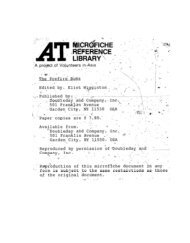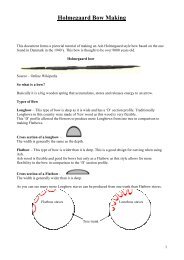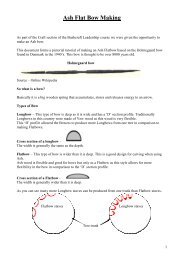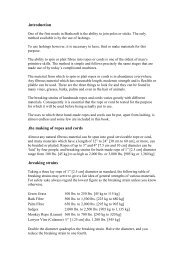Experiments on Knife Sharpening John D. Verhoeven ... - BushcraftUK
Experiments on Knife Sharpening John D. Verhoeven ... - BushcraftUK
Experiments on Knife Sharpening John D. Verhoeven ... - BushcraftUK
Create successful ePaper yourself
Turn your PDF publications into a flip-book with our unique Google optimized e-Paper software.
Figs 23 to 26. It appears that the c<strong>on</strong>venti<strong>on</strong>al ceramic st<strong>on</strong>e does not abrade the metalaway as rapidly as the waterst<strong>on</strong>es. The more jagged and burred edge shown in thecentral Up face micrograph of Fig. 28 might result in part because the lower abrasi<strong>on</strong> ratehas not removed adequate material to remove the more highly burred and jagged edgeproduced <strong>on</strong> the 600 grit c<strong>on</strong>trol blades. Although the waterst<strong>on</strong>es appear to be clearlysuperior to the c<strong>on</strong>venti<strong>on</strong>al st<strong>on</strong>e, additi<strong>on</strong>al experiments are required to c<strong>on</strong>firm thisc<strong>on</strong>clusi<strong>on</strong>. It may be that the c<strong>on</strong>venti<strong>on</strong>al st<strong>on</strong>e simply requires more extensiveabrasi<strong>on</strong> than the waterst<strong>on</strong>es require.The DMT diam<strong>on</strong>d h<strong>on</strong>e kit is supplied with a jig to hold the blade at a fixedangle while sharpening. This jig was used for the diam<strong>on</strong>d h<strong>on</strong>e experiment rather thanthe Razor Edge holder of Fig. 21. As with the Razor Edge holder experiments theholding jig was set to produce the same 2β edge angle of 48 o . Two of the 1000 gritc<strong>on</strong>trol blades were sharpened with the diam<strong>on</strong>d h<strong>on</strong>e using 2 passes per side and 6passes per side with the directi<strong>on</strong> of the abrasi<strong>on</strong> being into the edge of the blade.Unfortunately the number of passes was significantly less than was used <strong>on</strong> the aboveexperiments so a direct comparis<strong>on</strong> is limited. Figure 29 presents 2 views of the bladesharpened with 2 passes per side and 1 view of the blade sharpened with 6 passes perside. The lower number of sharpening passes has abraded a narrower regi<strong>on</strong> away fromthe original as-ground edge than was the case for the waterst<strong>on</strong>es. Nevertheless, theresults show that the 1200 grit diam<strong>on</strong>d h<strong>on</strong>e has produced significantly larger abrasi<strong>on</strong>grooves <strong>on</strong> the blade faces and has resulted in a rougher edge than found with thewaterst<strong>on</strong>es.C<strong>on</strong>clusi<strong>on</strong>s1 Japanese waterst<strong>on</strong>es in the 6000 to 8000 grit range produced an excellent edge <strong>on</strong>these HRC = 60 stainless steel blades with as-ground 2β edge angles of around 40 o . Thewaterst<strong>on</strong>es produced fairly smooth and quite straight edges as viewed face-<strong>on</strong>. Theremnant bur width was quite small, <strong>on</strong> the order of 0.5 micr<strong>on</strong>s. The edge quality wasindependent of the size of the burs left from the original grinding with either 600 grit or23








